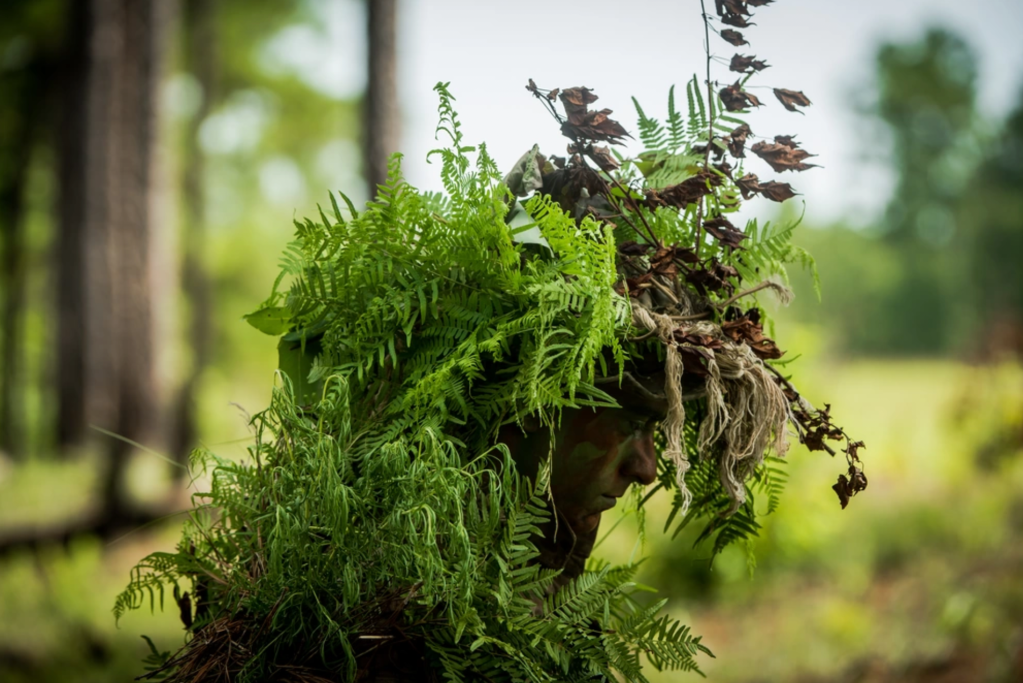

The two men crawl stealthily through the Panamanian jungle. Their faces are painted with hues of black, brown and green. Their bodies are covered by the burlap strands and interwoven foliage of their ghillie suits. The sniper and his spotter reach a vantage point overlooking the village and search for their target, a Panamanian rebel leader. Camouflaged against the jungle by their ghillie suits, the two men spot their target. As the rebel leader bites into his apple, a single shot pierces the stillness of the jungle and a 7.62x51mm NATO round pierces his heart.
One shot, one kill.
Alerted to the threat, the rebels frantically spray the jungle with automatic fire. Unable to see their enemy, they fire their weapons haphazardly and pray not to be the sniper’s next victim. Invisible to the rebels, the sniper ejects the spent cartridge from his M40A1 rifle and hands it to his spotter. As civilians in the village take cover, the rebels continue to pour gunfire into the jungle with no specific target. When no shots return from the trees, they cease fire. Still unseen, the sniper and his spotter melt back into the jungle and disappear. The only evidence of them having been there is the dead body of the rebel leader, a single hole through his heart.

The 1993 film Sniper, starring Tom Berenger as the titular and aforementioned sniper, introduced many viewers to the ghillie suit. An integral part of a sniper’s kit, the ghillie suit allows the sniper to blend in with their surroundings and evade detection. This is key to accomplishing their mission since a sniper’s primary functions on the battlefield are conducting covert reconnaissance and delivering precision fires.
What is a ghillie suit?
A ghillie suit is typically made of a net or cloth garment and covered in burlap strips, cloth, or twine. It has an irregular shape which breaks up a sniper’s outline and makes them more difficult to spot. Additionally, snipers can weave local flora into their ghillie suit in order to better blend with their surroundings. If done properly, this additional camouflage will even sway in the wind to match the environment it is replicating. Today, ghillie suits are used by snipers all around the world in foliage, sand, and even snow. Their origin, however, can be traced back to the game attendants and folklore of the Scottish Highlands.
Origin of the ghillie suit
Derived from the Scottish Gaelic word “gille,” meaning lad or servant, a ghillie (the English misspelling) is a man or boy who serves as a game attendant and specializes in fishing, stalking and hunting. In Scottish folklore, the Gille Dubh was a timid but wild male fairy who roamed the Highlands. Like the suit that bears his name, the Gille Dubh was clothed in leaves and other vegetation which allowed him to camouflage in the Highlands and evade capture.

Scottish ghillies created the ghillie suit in the turn of the 20th century as a wearable hunting blind that would allow them to more stealthily stalk and hunt their game on the Highlands. These first ghillie suits were made primarily of burlap which were irregularly torn and cut to break up the ghillie’s silhouette. Almost immediately, the ghillie suit saw military application with the British Army during the Second Boer War (1899-1902). The Lovat Scouts, the British Army’s first sniper unit, were initially recruited from Scottish Highland estate workers. This included the ghillies who brought their burlap camouflage suits with them.
The ghillie suit went to war again in WWI where other nations took notice of its effectiveness and adopted it for themselves. As a concept, the ghillie suit has remained largely unchanged since its inception. One notable upgrade came in June 2003 when the U.S. Army introduced a new ghillie suit made of a lightweight, fire-resistant, and self-extinguishing fabric instead of the heavier and flammable burlap.

Today, snipers around the world continue to carefully craft their ghillie suits in order to camouflage themselves and evade detection by the enemy. Meanwhile, in the Scottish Highlands, professional ghillies continue to preserve their legacy as gamekeepers. They cull game herds and lead hunting expeditions, sometimes with the added camouflage of their iconic burlap suit.
READ MORE ON WATM:
Travis Kelce’s grandfather was shot down 3 times during WWII
The real-life TOPGUN advisors made cameos in ‘Top Gun’ and ‘Top Gun: Maverick’
